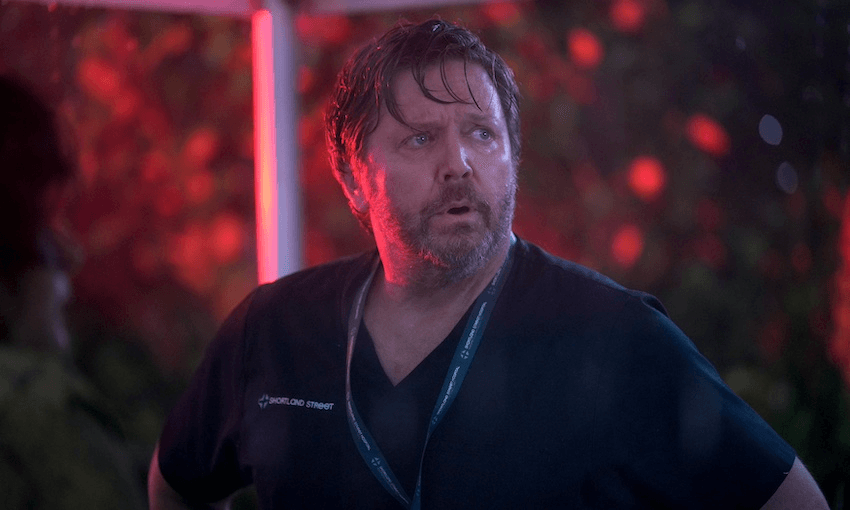Rose Matafeo calls Horndog a ‘silly show about love’, but what follows is a persuasive case for loving with obsessive devotion.
Rose Matafeo assures us in the first few minutes of Horndog (now streaming on Neon) that it’s not a TED talk, that it won’t be one of those shows where there’s a “lesson to be learned”, and that it’s not really about horniness. It is, of course, all of those things.
Horndog is a fitting companion to Matafeo’s podcast, Boners of the Heart. She can create a beautiful sense of bathos by taking the base teenage energy of boners and horniness, and fusing it with the joyful throws of higher love. The way she uses the word “horniness” isn’t what the rest of us necessarily mean. She describes what’s coming as a “a silly show about love” but about a specific kind of obsessive love that “almost feels like it’s bursting out of your heart”; the kind of unregulated obsession that is generally associated with teenage girls. She describes this love as horniness because there’s no other word she could think of that aptly described the feeling. She then goes on to show us that there’s nothing silly about those loves at all.
On first watch, the show felt unstructured and rambly, like we were following Matafeo through the woods and she was running ahead, skipping over roots, getting distracted by birds. At one point she said, “Where was I?” and linked back to a story from 10 minutes ago about girls doing choreographed dances to K-pop, which I’d forgotten she’d even been talking about. There was a jittery tremor to her voice that felt distinctly uncomfortable to watch.
I was happy to be led through the woods in this way, not concerned that I had no idea where she was taking me, because the journey was so joyful and resonant. She talks about the disappointment of being straight (relatable), Neopets guilds, and the kind of universal memories of youth that makes me want to tell groups of teens, “It will get better, I promise.” There was a bit about curly hair that made me feel seen, and some early internet humour, which everyone loves, right? I kept wishing I was watching it with someone, or that I could extract soundbites to send to whoever would gush and agree that yes, we’ve experienced all of this too. This happened to us.
Of course, Horndog didn’t win best show at the Edinburgh Fringe Festival for nothing. The show might have felt like a ramble, but she’d known where we were going the whole time. The wild rampage through the woods was a journey of her obsessions. The things Matafeo talked about loving ranged from the relatable (Love Island), heart-breaking (every past love), to the niche (what her reaction will be the moment she hears an ex has moved on).
That nervous excitability that had me so uncomfortable captured the frantic energy of obsession. It’s the same energy with which I used to talk about the musical evolution of 5ive, or the way I will repeat every detail of Louisa May Alcott’s life whether you want to hear it or not, sharply aware that I should stop talking but just can’t. Her nervy delivery couldn’t have been any other way, because there is nothing elegant or composed about obsession. There’s a fury about it. You can’t love something that much without hating it a little bit, or at least hating the breath-taking agony of that love, which is impossible to satisfy. It’s a bottomless hole that only wants more and more of the thing.
Twice in the show, Matafeo seems to lose her place, she stutters over her words, then dives into a stunning, piercingly beautiful monologue, before hitting us again with the laughs. The move is so quick and bright, it felt like someone turned a light on so suddenly it blinds you, only to shut it off just as fast, leaving you blind again in the dark. The first of these monologues is about how love never leaves your body but crystallises inside you like a horcrux. The second is a teary speech about how devoting so much love to something, whether it’s K-pop or Franz Ferdinand, is always worth it, and how any kind of heartbreak is inverse to the love you experienced for that thing, and love is always valuable, no matter the grief that can come behind it. Loving is less about whether the object of love is worthy, but more about the kind of person you want to be.
On the second watch of Horndog, I was distracted and kept having to pause and rewind because the person I’m obsessed with was sending me song lyrics he loves, and tracks for my commute in the morning. I was vaguely wondering why him copy/pasting the words for Nick Cave’s ‘Into My Arms’ made me want to drive to his house in the middle of the night. And then Matafeo’s final monologue explained it in real time. It fit together almost too well. It’s because, as she says in the opening moments, we are what we love. In sending someone the things you love, you’re showing them who you are. You’re gifting the feeling of love.
Horndog isn’t just a rambling, excitable rant about things Matafeo loves. It’s an invocation to give yourself over to love, to give yourself up to it, and to see all love, any love, as a thing of great worth. It is absolutely a TED talk, I absolutely learned something, and I’m absolutely a horndog for it.
Rose Matafeo: Horndog is streaming on Neon now.



